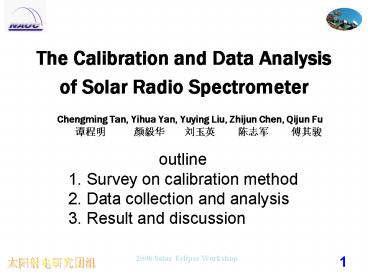The Calibration and Data Analysis of Solar Radio Spectrometer
1 / 18
Title:
The Calibration and Data Analysis of Solar Radio Spectrometer
Description:
... frequency, use a fit method (non-linear least squares fit ) to fit a curve of ... Square fit method. Use the smooth. coeff. Curve in. stead of const. coeff. ... –
Number of Views:77
Avg rating:3.0/5.0
Title: The Calibration and Data Analysis of Solar Radio Spectrometer
1
The Calibration and Data Analysisof Solar Radio
Spectrometer
- Chengming Tan, Yihua Yan, Yuying Liu, Zhijun
Chen, Qijun Fu - ??? ??? ??? ???
???
- outline
- Survey on calibration method
- Data collection and analysis
- Result and discussion
2
1 Survey on Calibration Method
- Absolute Calibration.
- Relative Calibration (gain factor in linear
range). - 1. Daily coefficient calibration.
- 2. Constant coefficient(single Fre.).
- havent been applied at Solar Radio Spectrum
- Nonlinear Calibration (gain factor not in linear
range )
3
1.1 Absolute Calibration
- For a wide-angle single dish antenna,the flux
unit of spot source is - Sf is flux unit (FU) at different frequency
- 8p? K?2 are constant
- etsec(z) is refraction factor of
atmosphere,assume to 1 - ?TA is antenna temperature of the source
- Observe the standard source, get the gain factor
G?D0 - After that, calculate the FU for every ?TA?
4
1.2 Relative Calibration
- Till now,we use the calibration method that
advanced systematically by Tanaka et al. (1973)
5
1.2 Fundamental Theory
Antenna
Receiver
computer
- radio emission of the source ( Ts, Tb )
- emission of standard noise source (Tn, Tt )
- frequency property of the antenna
- frequency property of the receiver
6
If the gain of the receiver is linear and stable,
then
record
3
1
2
4
7
121 Daily Calibration
- Thus the formula
- is standard
flux unit of the quiet solar radio emission at
fixed frequency (internet or SGD)
- So, the daily calibration formula is
8
122 Constant Coefficient Calibration
- The ratio
- quiet solar radio emission
- The calibration coeff. Value C0S0(f)/r0
The Calibration coeff. is consist of two
properties property of the antenna system and
property of the noise source.
Formula (Constant coeff. calibration)
9
13 Nonlinear Calibration
- When solar radio emission is large, the gain
factor maybe out of normal range of the receiver.
Linear calibration will result big error,
nonlinear calibration should be considered. (Yan,
Tan, Xv, et al 2002)
Be careful the response range
After system adjust
10
2 data collection and analysis
- Daily calibration data
? - SGD data solar quiet radio emission (flux unit)
at 245, 410, 610, 1415, 2695,4995,8800,15400MHz - Data Analysis
- Organize the data in 3 parts for 3 bands?
- For each part, there are many channels
(frequency), calculate the calibration coeff. for
each day and each frequency - For each frequency, use a fit method (non-linear
least squares fit ) to fit a curve of calibration
coeff. - Use the calibration coeff. curve calculate the
flux of quiet solar radio emission. And compare
the result with standard solar flux at fixed
frequency! - The property of quiet solar radio emission (by
Huairou)
11
2.1 Daily calibration data
- 3 spectrometers
- (1.0-2.0, 2.6-3.8, 5.2-7.6 GHz)
- 1 single frequency (2840 MHz)
- Use the HuaiRS.pro save the daily calibration
data.
12
2.2 Standard flux of quiet solar radio emission
(1996-2008)
- Download the standard flux of quiet solar radio
emission at 9 fixed frequency from internet (SGD
or others), then use linear extrapolation to
calculate flux at other frequency.
13
Calibration coeff.
The coeff. variated not very large in several
months. So, fit each spot (one day a spot) in use
of several months data! (Some spot should be
exclude!)
Second-order least Square fit method
Use the smooth coeff. Curve in stead of
const. coeff.
14
Coeff. and the air temperature
15
Result (Coeff. curve calibration )
Black SGD
Red Huairou
Errorlt 13
Only for 2001-2004
16
Quiet solar radio emission
Black SGD
Mean value during 2001-2004 (0 lt Sfu lt1000)
Red Huairou
17
3 result and discussion
- All the data collection.
- The coeff. Curve for calibration.
- The relationship between calibration coeff. and
air temperature. - First result of the flux of quiet solar radio
emission. - The reason of the error(need more work)
- Unstable of the feed, cable, and noise source
(bad channel and data) - Big burst, gain factor maybe out of normal range
- Emission of background
- Quiet solar radio emission? (sunspot or flare)
- Other interference
- Absorb of atmosphere
- SGD flux (only 9 spot, accuracy?)
18
Thank you!































